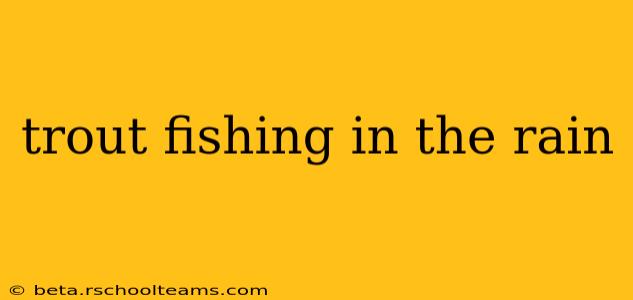Trout fishing in the rain can be incredibly rewarding, offering a unique and often less crowded experience. However, it requires adapting your techniques and gear to the changing conditions. This comprehensive guide will cover everything you need to know to successfully fish for trout during a downpour.
Is it Worth Fishing for Trout in the Rain?
Many anglers avoid fishing in the rain, mistakenly believing trout stop feeding. This is largely untrue. While heavy downpours might temporarily reduce activity, rain often creates ideal fishing conditions. The increased water flow can oxygenate the water, and the runoff can carry insects and other food sources into the river or stream, attracting hungry trout. Furthermore, the reduced angler pressure means you might have prime fishing spots all to yourself.
What Gear is Best for Rainy Trout Fishing?
Proper gear is crucial for a comfortable and successful rainy fishing trip. Investing in waterproof and breathable clothing is paramount. Consider:
- Waterproof jacket and pants: Look for breathable fabrics to prevent overheating.
- Waterproof boots: Choose boots with good ankle support and traction for slippery riverbanks.
- Waterproof backpack: Protect your electronics and other gear.
- Rain hat or hood: Keep your head and eyes dry.
- Waterproof gloves: Maintain dexterity and warmth.
Beyond clothing, consider these:
- Waterproof reel: Protecting your reel from water damage is essential.
- Waterproof fly box: Keep your flies dry and organized.
- Polarized sunglasses: Reduce glare and improve visibility even in the rain.
What Flies Work Best When Fishing for Trout in the Rain?
Rain affects insect activity, thus influencing the best fly choices. Consider these:
- Emergers: Imitate insects struggling to emerge from the water's surface.
- Drowned insects: Represent insects that have fallen into the water.
- Streamers: Mimic small fish and other aquatic prey, which are often more active in turbulent water.
- Larger, darker flies: These are more visible in murky water.
Adjust your fly selection based on the intensity of the rain and the specific insects present in your fishing location.
What are the Best Techniques for Trout Fishing in the Rain?
Rainy conditions often dictate a change in fishing techniques.
- Slow and deliberate presentation: Trout might be less aggressive in the rain, requiring a slow, accurate presentation of your fly or lure.
- Downstream drifts: Allow the current to carry your fly naturally.
- Use of weighted flies or lures: Helps get your fly down to where the trout are feeding.
- Focus on cover: Trout seek shelter under overhanging branches and in deeper pools during rain.
How Does the Water Level Affect Trout Fishing in the Rain?
Rising water levels from heavy rain can significantly impact trout fishing.
- Increased flow: Can make fishing more challenging but also push food sources into favorable feeding areas.
- Swollen rivers: May require heavier lines and weighted flies/lures.
- Murky water: Can reduce visibility, necessitating the use of larger, brighter flies.
Observe the water level and adjust your technique accordingly.
What are the Safest Practices for Trout Fishing in the Rain?
Safety should always be a priority when fishing in the rain.
- Check the weather forecast: Be aware of potential flash floods or severe weather.
- Wear high-visibility clothing: Improve visibility in low-light conditions.
- Inform someone of your fishing plans: Let someone know your location and expected return time.
- Be aware of slippery conditions: Take extra caution on riverbanks and around water.
By understanding these factors and adapting your techniques and gear, you can have a successful and enjoyable trout fishing experience even in the rain. Remember, careful preparation and observation are key to success in any fishing scenario, but especially when the weather throws a curveball.
